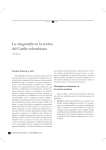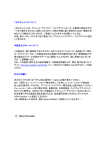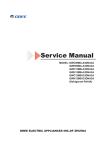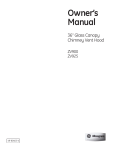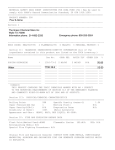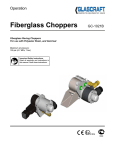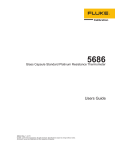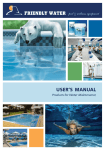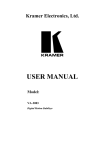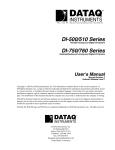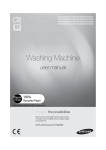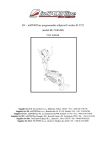Download Users Guide
Transcript
5900E
Mercury Triple Point Cell
Users Guide
2004, Rev. 1, 4/11
© 2004 - 2011 Fluke Corporation. All rights reserved. Specifications subject to change without notice.
All product names are trademarks of their respective companies.
Limited Warranty & Limitation of Liability
Each Fluke product is warranted to be free from defects in material and workmanship under normal use and service.
The warranty period is one year and begins on the date of shipment. Parts, product repairs, and services are warranted
for 90 days. This warranty extends only to the original buyer or end-user customer of a Fluke authorized reseller, and
does not apply to fuses, disposable batteries, or to any product which, in Fluke’s opinion, has been misused, altered,
neglected, contaminated, or damaged by accident or abnormal conditions of operation or handling. Fluke warrants
that software will operate substantially in accordance with its functional specifications for 90 days and that it has been
properly recorded on non-defective media. Fluke does not warrant that software will be error free or operate without
interruption.
Fluke authorized resellers shall extend this warranty on new and unused products to end-user customers only but have
no authority to extend a greater or different warranty on behalf of Fluke. Warranty support is available only if product
is purchased through a Fluke authorized sales outlet or Buyer has paid the applicable international price. Fluke reserves
the right to invoice Buyer for importation costs of repair/replacement parts when product purchased in one country is
submitted for repair in another country.
Fluke’s warranty obligation is limited, at Fluke’s option, to refund of the purchase price, free of charge repair, or
replacement of a defective product which is returned to a Fluke authorized service center within the warranty period.
To obtain warranty service, contact your nearest Fluke authorized service center to obtain return authorization
information, then send the product to that service center, with a description of the difficulty, postage and insurance
prepaid (FOB Destination). Fluke assumes no risk for damage in transit. Following warranty repair, the product will
be returned to Buyer, transportation prepaid (FOB Destination). If Fluke determines that failure was caused by neglect,
misuse, contamination, alteration, accident, or abnormal condition of operation or handling, including overvoltage
failures caused by use outside the product’s specified rating, or normal wear and tear of mechanical components, Fluke
will provide an estimate of repair costs and obtain authorization before commencing the work. Following repair, the
product will be returned to the Buyer transportation prepaid and the Buyer will be billed for the repair and return
transportation charges (FOB Shipping Point).
THIS WARRANTY IS BUYER’S SOLE AND EXCLUSIVE REMEDY AND IS IN LIEU OF ALL OTHER
WARRANTIES, EXPRESS OR IMPLIED, INCLUDING BUT NOT LIMITED TO ANY IMPLIED WARRANTY OF
MERCHANTABILITY OR FITNESS FOR A PARTICULAR PURPOSE. FLUKE SHALL NOT BE LIABLE FOR ANY
SPECIAL, INDIRECT, INCIDENTAL, OR CONSEQUENTIAL DAMAGES OR LOSSES, INCLUDING LOSS OF
DATA, ARISING FROM ANY CAUSE OR THEORY.
Since some countries or states do not allow limitation of the term of an implied warranty, or exclusion or limitation
of incidental or consequential damages, the limitations and exclusions of this warranty may not apply to every buyer.
If any provision of this Warranty is held invalid or unenforceable by a court or other decision-maker of competent
jurisdiction, such holding will not affect the validity or enforceability of any other provision.
Fluke Corporation
Fluke Europe B.V.
P.O. Box 9090
P.O. Box 1186
Everett, WA 98206-9090
5602 BD Eindhoven
U.S.A.The Netherlands
11/99
Table of Contents
Title
Page
Before You Start...................................................................................................................1
Symbols Used..................................................................................................................1
Safety Information...........................................................................................................1
How to Contact Fluke......................................................................................................2
Introduction..........................................................................................................................2
Specifications and Environmental Conditions.....................................................................3
Specifications...................................................................................................................3
Environmental Conditions...............................................................................................3
Description...........................................................................................................................3
Care of Your Mercury Triple Point Cell..............................................................................3
Realization of the Triple Point of Mercury..........................................................................3
Correction for the Pressure Difference................................................................................5
Material Safety Data Sheet..................................................................................................7
i
5900E
Users Guide
ii
List of Tables
Table
Page
Title
Table 1. International Electrical Symbols................................................................................................1
Table 2. Some Subranges of the ITS-90 and the Fixed Points Required for Calibration........................2
Table 3. Correction for Pressure Difference............................................................................................5
iii
5900E
Users Guide
iv
List of Figures
Figure
Title
Page
Figure 1. Typical Usable Mercury (Hg) Melt Plateau.............................................................................4
v
5900E
Users Guide
vi
Before You Start
Symbols Used
Table 1 lists the International Electrical Symbols. Some or all of these symbols may be used on
the instrument or in this manual.
Table 1. International Electrical Symbols
Symbol
Description
Symbol
Description
O
Off
I
On
X
Electric Shock
:
Hot Surface (Burn Hazard)
W
Read the User’s Manual
(Important Information)
I
B
D
AC (Alternating Current)
M
F
DC
)
Canadian Standards Association
T
Double Insulated
P
CE Complies with European Union
Directives
.
AC-DC
PE Ground
;
Fuse
Battery
C-TIC Australian EMC Mark
CAT II equipment is designed to
protect against transients from energyequipment supplied from
CAT II consuming
the fixed installation, such as TVs, PCs,
portible tools, and other household
appliances.
Safety Information
Use this instrument only as specified in this manual. Otherwise, the protection provided by the
instrument may be impaired.
The following definitions apply to the terms “Warning” and “Caution”.
• “Warning” identifies conditions and actions that may pose hazards to the user.
• “Caution” identifies conditions and actions that may damage the instrument being used.
Warning
To avoid personal injury, follow these guidelines.
• Mercury is corrosive. Consult the metal manufacturer’s MSDS (Material
Safety Data Sheet).
• Contains mercury, dispose properly.
• Federal law prohibits carrying this cell in the passenger section of a
commercial airline. See MSDS in the back of this manual.
1
5900E
Users Guide
Caution
To avoid possible damage to the instrument, follow these guidelines.
• Read the section entitled, Care and Handling Guidelines, before removing the
gallium melting point cell from the case. Incorrect handling can damage the cell.
• The mercury triple point cell must be kept in a vertical position. Placing the cell
in a horizontal position can damage the cell and void the warranty.
How to Contact Fluke
To contact Fluke, call one of the following telephone numbers:
• Technical Support USA: 1-800-44-FLUKE (1-800-443-5853)
• Calibration/Repair USA: 1-888-99-FLUKE (1-888-993-5853)
• Canada: 1-800-36-FLUKE (1-800-363-5853)
• Europe: +31 402-675-200
• Japan: +81-3-3434-0181
• Singapore: +65-738-5655
• Anywhere in the world: +1-425-446-5500
Or, visit Fluke’s website at www.fluke.com.
To register your product, visit http://register.fluke.com.
To see, print, or download the latest manual supplement, visit
http://us.fluke.com/usen/support/manuals.
Introduction
The International Temperature Scale of 1990 (ITS-90) is based on a series of defining fixed
points. The triple point of mercury (TPHg) is one of the defining fixed points of the ITS-90. A
triple point is the phase equilibrium state of solid, liquid, and vapor. The most common triple
point used in the ITS-90 is the triple point of water. At temperatures below 273.16 K, most of
the defining fixed points of the ITS-90 are the triple points. The TPHg is assigned the value
234.3156 K (–38.8344°C) by the ITS-90. Extremely pure mercury (99.999999%) can produce
both freezing and melting techniques which give the triple point temperatures that agree to within
± 0.1 mK over most of the usable plateau. Since the triple point of mercury is notably below
ambient, the melting curve is easier to realize with a longer plateau.
The fixed points are indispensable for the calibration of a standard platinum resistance
thermometer (SPRT). Different subranges require different sets of fixed points. The ITS-90
specifies five subranges, in which SPRTs must be calibrated at the TPHg (Table 2).
Table 2. Some Subranges of the ITS-90 and the Fixed Points Required for Calibration
Subrange
Fixed Points Required
13.8033 K to 273.16 K
TP e-H2, TPNe, TPO2, TPAr, TPHg, and TPH2O
24.5561 K to 273.16 K
TP e-H2, TPNe, TPO2, TPAr, TPHg, and TPH2O
54.3584 K to 273.16 K
TPO2, TPAr, TPHg, and TPH2O
83.8058 K to 273.16 K
TPAr, TPHg, and TPH2O
234.3156 K to 29.7646 K
TPHg, TPH2O, and MPGa
For your convenience Fluke has developed a sealed TPHg cell according to BNM-INM design
and technology, which makes it easier to realize the TPHg. The Fluke sealed TPHg cells will
assist you immensely in realizing the TPHg in your laboratory.
2
Mercury Triple Point Cell
Specifications and Environmental Conditions
Specifications and Environmental Conditions
Specifications
ITS-90 Assigned Temperature ......................................... 234.3156 K (–38.8344°C)
Expanded Uncertainty (k=2)............................................ 0.2 mK
Purity of Mercury.............................................................. 99.999999+% (8N+)
Quantity of Mercury.......................................................... 2,000 g
Outer Diameter of the Cell............................................... 38.1 mm (1.5 in)
The Length of the Cell...................................................... 246.0 mm (9.68 in)
The Total Length of the Cell with the Reentrant Well....... 400 mm (15.75 in)
Inner Diameter of the Reentrant Well............................... 8.0 mm (0.315 in)
Total Immersion Depth in Mercury................................... 210 mm
Total Length of the Reentrant Well................................... 381 mm (15 in)
Case Material................................................................... 304L Stainless Steel
Environmental Conditions
Although the instrument has been designed for optimum durability and trouble-free operation,
it must be handled with care. The instrument should not be used in an excessively dusty or dirty
environment.
Description
The Fluke TPHg cell is manufactured according to BNM-INM design and technology (Y.
Hermier, G. Bonnier, “The Mercury Point Realization: Estimate of Some Uncertainties”,
TMCSI, vol. 6, p. 287, 1992). During the manufacturing process, every cell is leak tested.
After the cleaning and filling processes are complete, two small tubes adjacent to the central
well are crimped and welded providing a sealed cell. A sealed cell is convenient in avoiding
moisture condensation and contamination. An open cell with a bellow-sealed valve is available
upon request. Sealed cells are more convenient for most users while open cells might be more
preferable for some national laboratories.
304L stainless steel is chosen as the cell case material because it has been proven that it won’t
contaminate high-purity mercury and it is much stronger than borosilicate glass. Stainless steel
is preferred over borosilicate glass as the cell case material since mercury-in-borosilicate glass
cells have been found to super cool about 6°C, while stainless steel cells super cool only 0.1°C to
0.3°C.
Care of Your Mercury Triple Point Cell
The mercury triple point cell is completely sealed and requires very little maintenance. It is
suggested that the cell be kept in the vertical position for safety, although putting a cell in the
horizontal orientation for a short time period will not cause any damage. Extended placement in a
horizontal position may cause the mercury to come in contact with the welded closures and is not
recommended.
Condensation on the outside of the cell should be removed before storage of the cell to prevent
any corrosion.
The vacuum state of the cell produces a hydrostatic hammer as the mercury comes in contact with
the cell walls. The hammer or “click” provides audible evidence that the cell integrity is in tact.
Realization of the Triple Point of Mercury
The purity of mercury used in the 5900E cell is 99.999999+%. At such high levels of purity both
freezing and melting techniques yield triple-point values within ± 0.1 mK over most of liquidsolid range. Therefore, both freezing and melting techniques may be used for the realization of
the triple point of mercury.
3
5900E
Users Guide
Since the triple point of mercury is about 60°C below room temperature, the melting technique
is easier to realize and has a longer plateau. It is suggested that most users realize the triple
point of mercury using the melting technique. The realization of metal fixed points with the
lowest uncertainty generally requires two liquid-solid interfaces. In such a situation, the outer
liquid-solid interface adjacent to the outer wall of the cell advances slowly as the solid continues
to melt (the melting curve), or as the liquid continues to solidify (the freezing curve). Ideally
this generates a shell of liquid phase (or solid phase) that continues to be of uniform thickness
completely surrounding the solid mercury (or liquid mercury), which itself surrounds the inner
liquid-solid interface that is adjacent to the thermometer well. With SPRTs, the inner liquid-solid
interface, i.e., the equilibrium whose temperature is measured, must surround and be as close to
the temperature sensing element as possible. An inner melting technique, which we will discuss
in detail later, will create a continuous inner liquid-solid interface that is adjacent to the reentrant
well.
The realization of the melting curve of the mercury triple point is accomplished in a bath with a
minimum depth of 457 mm (18”), such as Fluke models 7341 and 7381 liquid baths. A serviceable
plateau can be maintained for 8 hours in the 7341 bath and plateaus longer than 24 hours have
been realized.
The length of the plateau is dependent upon the number of SPRTs being calibrated and the precooling of the SPRTs.
Typical Usable Mercury (Hg) Melt Plateau
-38.8310
-38.8315
Temp (°C)
-38.8320
-38.8325
-38.8330
12 Hours
-38.8335
-38.8340
-38.8345
-38.8350
Time
Hg Plateau.eps
Figure 1. Typical Usable Mercury (Hg) Melt Plateau
In order to realize the mercury melting plateau in the 7341 bath, fill the cell reentrant well with
alcohol and place the cell in the bath. You need to use the 2027-DCBM cell holder. Set the bath
at -45°C. It will take approximately 2 hours for the cell to freeze. It may be convenient to freeze
the cell overnight so that work can begin first thing in the morning. Your check standard should be
placed in the well during the freeze. You may or may not be able to see the supercool depending
on the thermal conditions. Set the bath to -40°C and maintain at that temperature until stable.
Since calibration baths are not calibrated, the bath temperature will not be precise. Use the known
value of the check standard at the mercury triple point to calculate the offset required for the bath
to hold a temperature 50 m°C (50 mK) higher than the triple point of mercury (-38.8344°C). Use
the calculated offset to set the bath temperature so that the check standard will read -38.784°C.
Remove the check standard from the cell and place it in a pre-cool hole. Place a room temperature
quartz glass rod or closed-ended tube in the reentrant well for 3 minutes to obtain an inner liquidsolid interface by melting the solid mercury immediately adjacent to the reentrant well surface.
Remove the quartz-glass rod and replace the check standard. Wait 30 minutes to take the first
reading. ALWAYS TAKE THE FIRST READING WITH THE CHECK STANDARD.
Proceed to calibrate the SPRTs. Check the condition of the melt after every three SPRT readings.
Not
Pre-chilling each SPRT to be calibrated is extremely important to maximize the length of
the usable plateau.
4
Mercury Triple Point Cell
Correction for the Pressure Difference
Correction for the Pressure Difference
The triple point is realized at the vapor/liquid/solid interface. This occurs only at the uppermost
surface of the mercury. Since mercury is extremely dense, considerable static head pressure is
present at the bottom of the entrant well or measurement point. Therefore, a correction must be
applied to the theoretical triple point temperature. ITS-90 gives all of the necessary coefficients
for the calculation of the correction caused by the pressure difference, which are summarized in
Table 3.
Table 3. Correction for Pressure Difference
Substance
Assigned
Value of
Equilibrium
Temperature
Temperature
with
Pressure, p
Variation with
Depth
Approximate
T
Kelvin (K)
K1 ; dT/dp
(10-5 mK/Pa)
K2 : dT/dh
(mK/m)
dW/dt
Argon (T)
83.8058
25
3.3
0.004342
Mercury (T)
234.3156
5.4
7.1
0.004037
Water (T)
273.16
–7.5
–.73
0.003989
Gallium (M)
302.9146
–2.0
–1.2
0.003952
rin0Indium (F)
429.7485
4.9
3.3
0.003801
Tin (F)
505.078
3.3
2.2
0.003713
Zinc (F)
692.677
4.3
2.7
0.003495
Aluminum (F)
933.473
7.0
1.6
0.003205
Silver (F)
1234.93
6.0
5.4
0.002841
Gold (F)
1337.33
6.1
10
—
Copper (F)
1357.77
3.3
2.6
—
(T) – triple
point
(M) – melting
point
(F) – freezing
point
The correction of temperature caused by the static head pressure can be calculated by using the
following equation:
Equation 1: Static head pressure Correction
Δt = h × k2(1)
K1 = dT
dp
K2 = dT
, 7.1 mK/m for the triple point of mercury
dh
h: the immersion depth of the midpoint of the sensor of a SPRT into the matter used for the fixed
point The immersion depth of the midpoint of a SPRT sensor in a mercury triple point cell is
approximately 0.183 m The distance from the inner bottom of the central well to the surface of
liquid metal is about 0.208 m. If the distance of the midpoint of the sensor from the tip of the
sheath is 25 mm, the mean immersion depth of the SPRT sensor = 208 mm –25 mm = 183 mm.
The temperature correction, Δt, can be calculated using Equation 1.
[ Example ] Equation 1 to calculate Δt becomes:
Δt = h × k2
5
5900E
Users Guide
Substituting values into Equation 1:
Δt = 0.183m × 7.1mK
Consequently:
m
Δt =1.299mK = 0.001299K
Hence, the actual temperature of a sensor of a SPRT at the point of total immersion during a
plateau in the cell is calculated using Equation 2.
Equation 2: Calculation of the Actual Temperature, t1
t1 = t+Δt(2)
Therefore:
t1 = 234.3156K + 0.001299K = 234.316899K
where t is the assigned temperature value for TPHg, i.e. 234.3156K (–38.8344°C).
6
Mercury Triple Point Cell
Material Safety Data Sheet
Material Safety Data Sheet
06'61XPEHU0(IIHFWLYH'DWH6XSHUFHGHV
0(5&85<
3URGXFW,GHQWLILFDWLRQ
6\QRQ\PV4XLFNVLOYHUK\GUDUJ\UXP/LTXLG6LOYHU
&$61R
0ROHFXODU:HLJKW
&KHPLFDO)RUPXOD+J
3URGXFW&RGHV
-7%DNHU
0DOOLQFNURGW
&RPSRVLWLRQ,QIRUPDWLRQRQ,QJUHGLHQWV
,QJUHGLHQW&$61R3HUFHQW+D]DUGRXV
0HUFXU\<HV
+D]DUGV,GHQWLILFDWLRQ
(PHUJHQF\2YHUYLHZ
'$1*(5&25526,9(&$86(6%8516726.,1(<(6$1'5(63,5$725<75$&70$<%()$7$/,)
6:$//2:('25,1+$/('+$50)8/,)$%625%('7+528*+6.,1$))(&767+(.,'1(<6$1'
&(175$/1(592866<67(00$<&$86($//(5*,&6.,15($&7,21
-7%DNHU6$)7'$7$WP5DWLQJV3URYLGHGKHUHIRU\RXUFRQYHQLHQFH
+HDOWK5DWLQJ([WUHPH3RLVRQ
)ODPPDELOLW\5DWLQJ1RQH
5HDFWLYLW\5DWLQJ6OLJKW
&RQWDFW5DWLQJ6HYHUH/LIH
/DE3URWHFWLYH(TXLS*2**/(6/$%&2$79(17+22'3523(5*/29(6
6WRUDJH&RORU&RGH%OXH+HDOWK
MSDS1.eps
7
5900E
Users Guide
3RWHQWLDO+HDOWK(IIHFWV
,QKDODWLRQ
0HUFXU\YDSRULVKLJKO\WR[LFYLDWKLVURXWH&DXVHVVHYHUHUHVSLUDWRU\WUDFWGDPDJH6\PSWRPVLQFOXGHVRUHWKURDW
FRXJKLQJSDLQWLJKWQHVVLQFKHVWEUHDWKLQJGLIILFXOWLHVVKRUWQHVVRIEUHDWKKHDGDFKHPXVFOHZHDNQHVVDQRUH[LD
JDVWURLQWHVWLQDOGLVWXUEDQFHULQJLQJLQWKHHDUOLYHUFKDQJHVIHYHUEURQFKLWLVDQGSQHXPRQLWLV&DQEHDEVRUEHGWKURXJK
LQKDODWLRQZLWKV\PSWRPVVLPLODUWRLQJHVWLRQ
,QJHVWLRQ
0D\FDXVHEXUQLQJRIWKHPRXWKDQGSKDU\Q[DEGRPLQDOSDLQYRPLWLQJFRUURVLYHXOFHUDWLRQEORRG\GLDUUKHD0D\EH
IROORZHGE\DUDSLGDQGZHDNSXOVHVKDOORZEUHDWKLQJSDOHQHVVH[KDXVWLRQWUHPRUVDQGFROODSVH'HOD\HGGHDWKPD\RFFXU
IURPUHQDOIDLOXUH*DVWURLQWHQVWLQDOXSWDNHRIPHUFXU\LVOHVVWKDQEXWLWVDELOLW\WRSHQHWUDWHWLVVXHVSUHVHQWVVRPH
KD]DUG,QLWLDOV\PSWRPVPD\EHWKLUVWSRVVLEOHDEGRPLQDOGLVFRPIRUW
6NLQ&RQWDFW
&DXVHVLUULWDWRQDQGEXUQVWRVNLQ6\PSWRPVLQFOXGHUHGQHVVDQGSDLQ0D\FDXVHVNLQDOOHUJ\DQGVHQVLWL]DWLRQ&DQEH
DEVRUEHGWKURXJKWKHVNLQZLWKV\PSWRPVWRSDUDOOHOLQJHVWLRQ
(\H&RQWDFW
&DXVHVLUULWDWLRQDQGEXUQVWRH\HV6\PSWRPVLQFOXGHUHGQHVVSDLQEOXUUHGYLVLRQPD\FDXVHVHULRXVDQGSHUPDQHQWH\H
GDPDJH
&KURQLF([SRVXUH
&KURQLFH[SRVXUHWKURXJKDQ\URXWHFDQSURGXFHFHQWUDOQHUYRXVV\VWHPGDPDJH0D\FDXVHPXVFOHWUHPRUVSHUVRQDOLW\DQG
EHKDYLRUFKDQJHVPHPRU\ORVVPHWDOOLFWDVWHORRVHQLQJRIWKHWHHWKGLJHVWLYHGLVRUGHUVVNLQUDVKHVEUDLQGDPDJHDQG
NLGQH\GDPDJH&DQFDXVHVNLQDOOHUJLHVDQGDFFXPXODWHLQWKHERG\5HSHDWHGVNLQFRQWDFWFDQFDXVHWKHVNLQWRWXUQJUD\LQ
FRORU$VXVSHFWHGUHSURGXFWLYHKD]DUGPD\GDPDJHWKHGHYHORSLQJIHWXVDQGGHFUHDVHIHUWLOLW\LQPDOHVDQGIHPDOHV
$JJUDYDWLRQRI3UHH[LVWLQJ&RQGLWLRQV
3HUVRQVZLWKQHUYRXVGLVRUGHUVRULPSDLUHGNLGQH\RUUHVSLUDWRU\IXQFWLRQRUDKLVWRU\RIDOOHUJLHVRUDNQRZQVHQVLWL]DWLRQ
WRPHUFXU\PD\EHPRUHVXVFHSWLEOHWRWKHHIIHFWVRIWKHVXEVWDQFH
)LUVW$LG0HDVXUHV
,QKDODWLRQ
5HPRYHWRIUHVKDLU,IQRWEUHDWKLQJJLYHDUWLILFLDOUHVSLUDWLRQ,IEUHDWKLQJLVGLIILFXOWJLYHR[\JHQ*HWPHGLFDODWWHQWLRQ
LPPHGLDWHO\
,QJHVWLRQ
,QGXFHYRPLWLQJLPPHGLDWHO\DVGLUHFWHGE\PHGLFDOSHUVRQQHO1HYHUJLYHDQ\WKLQJE\PRXWKWRDQXQFRQVFLRXVSHUVRQ*HW
PHGLFDODWWHQWLRQLPPHGLDWHO\
6NLQ&RQWDFW
,PPHGLDWHO\IOXVKVNLQZLWKSOHQW\RIZDWHUIRUDWOHDVWPLQXWHVZKLOHUHPRYLQJFRQWDPLQDWHGFORWKLQJDQGVKRHV*HW
PHGLFDODWWHQWLRQLPPHGLDWHO\:DVKFORWKLQJEHIRUHUHXVH7KRURXJKO\FOHDQVKRHVEHIRUHUHXVH
(\H&RQWDFW
,PPHGLDWHO\IOXVKH\HVZLWKSOHQW\RIZDWHUIRUDWOHDVWPLQXWHVOLIWLQJORZHUDQGXSSHUH\HOLGVRFFDVLRQDOO\*HWPHGLFDO
DWWHQWLRQLPPHGLDWHO\
)LUH)LJKWLQJ0HDVXUHV
)LUH
1RWFRQVLGHUHGWREHDILUHKD]DUG
([SORVLRQ
1RWFRQVLGHUHGWREHDQH[SORVLRQKD]DUG
)LUH([WLQJXLVKLQJ0HGLD
8VHDQ\PHDQVVXLWDEOHIRUH[WLQJXLVKLQJVXUURXQGLQJILUH'RQRWDOORZZDWHUUXQRIIWRHQWHUVHZHUVRUZDWHUZD\V
6SHFLDO,QIRUPDWLRQ
,QWKHHYHQWRIDILUHZHDUIXOOSURWHFWLYHFORWKLQJDQG1,26+DSSURYHGVHOIFRQWDLQHGEUHDWKLQJDSSDUDWXVZLWKIXOO
MSDS2.eps
8
Mercury Triple Point Cell
Material Safety Data Sheet
IDFHSLHFHRSHUDWHGLQWKHSUHVVXUHGHPDQGRURWKHUSRVLWLYHSUHVVXUHPRGH8QGHUJRHVKD]DUGRXVUHDFWLRQVLQWKHSUHVHQFHRI
KHDWDQGVSDUNVRULJQLWLRQ6PRNHPD\FRQWDLQWR[LFPHUFXU\RUPHUFXULFR[LGH6PRNHPD\FRQWDLQWR[LFPHUFXU\RU
PHUFXULFR[LGH
$FFLGHQWDO5HOHDVH0HDVXUHV
9HQWLODWHDUHDRIOHDNRUVSLOO&OHDQXSSHUVRQQHOUHTXLUHSURWHFWLYHFORWKLQJDQGUHVSLUDWRU\SURWHFWLRQIURPYDSRU
6SLOOV3LFNXSDQGSODFHLQDVXLWDEOHFRQWDLQHUIRUUHFODPDWLRQRUGLVSRVDOLQDPHWKRGWKDWGRHVQRWJHQHUDWHPLVWLQJ
6SULQNOHDUHDZLWKVXOIXURUFDOFLXPSRO\VXOILGHWRVXSSUHVVPHUFXU\'RQRWIOXVKWRVHZHU865HJXODWLRQV&(5&/$
UHTXLUHUHSRUWLQJVSLOOVDQGUHOHDVHVWRVRLOZDWHUDQGDLULQH[FHVVRIUHSRUWDEOHTXDQWLWLHV7KHWROOIUHHQXPEHUIRUWKH86
&RDVW*XDUG1DWLRQDO5HVSRQVH&HQWHULV
-7%DNHU&,11$625%DQG5(6,625%DUHUHFRPPHQGHGIRUVSLOOVRIWKLVSURGXFW
+DQGOLQJDQG6WRUDJH
.HHSLQDWLJKWO\FORVHGFRQWDLQHUVWRUHGLQDFRROGU\YHQWLODWHGDUHD3URWHFWDJDLQVWSK\VLFDOGDPDJH,VRODWHIURPDQ\
VRXUFHRIKHDWRULJQLWLRQ'RQRWXVHRUVWRUHRQSRURXVZRUNVXUIDFHVZRRGXQVHDOHGFRQFUHWHHWF)ROORZVWULFWK\JLHQH
SUDFWLFHV&RQWDLQHUVRIWKLVPDWHULDOPD\EHKD]DUGRXVZKHQHPSW\VLQFHWKH\UHWDLQSURGXFWUHVLGXHVYDSRUVOLTXLG
REVHUYHDOOZDUQLQJVDQGSUHFDXWLRQVOLVWHGIRUWKHSURGXFW
([SRVXUH&RQWUROV3HUVRQDO3URWHFWLRQ
$LUERUQH([SRVXUH/LPLWV
26+$$FFHSWDEOH&HLOLQJ&RQFHQWUDWLRQ
PHUFXU\DQGPHUFXU\FRPSRXQGVPJP7:$VNLQ
$&*,+7KUHVKROG/LPLW9DOXH7/9
LQRUJDQLFDQGPHWDOOLFPHUFXU\DV+JPJP7:$VNLQ$1RWFODVVLILDEOHDVDKXPDQFDUFLQRJHQ
$&*,+%LRORJLFDO([SRVXUH,QGLFHV
WRWDOLQRUJDQLFPHUFXU\LQXULQHSUHVKLIWXJJFUHDWLQLQH
WRWDOLQRUJDQLFPHUFXU\LQEORRGHQGRIVKLIWXJO
9HQWLODWLRQ6\VWHP
$V\VWHPRIORFDODQGRUJHQHUDOH[KDXVWLVUHFRPPHQGHGWRNHHSHPSOR\HHH[SRVXUHVEHORZWKH$LUERUQH([SRVXUH/LPLWV
/RFDOH[KDXVWYHQWLODWLRQLVJHQHUDOO\SUHIHUUHGEHFDXVHLWFDQFRQWUROWKHHPLVVLRQVRIWKHFRQWDPLQDQWDWLWVVRXUFH
SUHYHQWLQJGLVSHUVLRQRILWLQWRWKHJHQHUDOZRUNDUHD3OHDVHUHIHUWRWKH$&*,+GRFXPHQW,QGXVWULDO9HQWLODWLRQ$0DQXDO
RI5HFRPPHQGHG3UDFWLFHVPRVWUHFHQWHGLWLRQIRUGHWDLOV
3HUVRQDO5HVSLUDWRUV1,26+$SSURYHG
,IWKHH[SRVXUHOLPLWLVH[FHHGHGDQGHQJLQHHULQJFRQWUROVDUHQRWIHDVLEOHDKDOIIDFHUHVSLUDWRUZLWKDPHUFXU\YDSRURU
FKORULQHJDVFDUWULGJHPD\EHZRUQIRUXSWRWHQWLPHVWKHH[SRVXUHOLPLWRUWKHPD[LPXPXVHFRQFHQWUDWLRQVSHFLILHGE\WKH
DSSURSULDWHUHJXODWRU\DJHQF\RUUHVSLUDWRUVXSSOLHUZKLFKHYHULVORZHVW$IXOOIDFHSLHFHUHVSLUDWRUZLWKDPHUFXU\YDSRU
RUFKORULQHJDVFDUWULGJHPD\EHZRUQXSWRWLPHVWKHH[SRVXUHOLPLWRUWKHPD[LPXPXVHFRQFHQWUDLWRQVSHFLILHGE\WKH
DSSURSULDWHUHJXODWRU\DJHQF\RUUHVSLUDWRUVXSSOLHUZKLFKHYHULVORZHVW)RUHPHUJHQFLHVRULQVWDQFHVZKHUHWKHH[SRVXUH
OHYHOVDUHQRWNQRZQXVHDIXOOIDFHSLHFHSRVLWLYHSUHVVXUHDLUVXSSOLHGUHVSLUDWRU:$51,1*$LUSXULI\LQJUHVSLUDWRUV
GRQRWSURWHFWZRUNHUVLQR[\JHQGHILFLHQWDWPRVSKHUHV
6NLQ3URWHFWLRQ
:HDULPSHUYLRXVSURWHFWLYHFORWKLQJLQFOXGLQJERRWVJORYHVODEFRDWDSURQRUFRYHUDOOVDVDSSURSULDWHWRSUHYHQWVNLQ
FRQWDFW
(\H3URWHFWLRQ
8VHFKHPLFDOVDIHW\JRJJOHVDQGRUDIXOOIDFHVKLHOGZKHUHVSODVKLQJLVSRVVLEOH0DLQWDLQH\HZDVKIRXQWDLQDQGTXLFN
GUHQFKIDFLOLWLHVLQZRUNDUHD
MSDS3.eps
9
5900E
Users Guide
3K\VLFDODQG&KHPLFDO3URSHUWLHV
$SSHDUDQFH
6LOYHUZKLWHKHDY\PRELOHOLTXLGPHWDO
2GRU
2GRUOHVV
6ROXELOLW\
,QVROXEOHLQZDWHU
'HQVLW\
S+
1RLQIRUPDWLRQIRXQG
9RODWLOHVE\YROXPH#&)
%RLOLQJ3RLQW
&)
0HOWLQJ3RLQW
&)
9DSRU'HQVLW\$LU 9DSRU3UHVVXUHPP+J
#&)
(YDSRUDWLRQ5DWH%X$F 6WDELOLW\DQG5HDFWLYLW\
6WDELOLW\
6WDEOHXQGHURUGLQDU\FRQGLWLRQVRIXVHDQGVWRUDJH
+D]DUGRXV'HFRPSRVLWLRQ3URGXFWV
$WKLJKWHPSHUDWXUHVYDSRUL]HVWRIRUPH[WUHPHO\WR[LFIXPHV
+D]DUGRXV3RO\PHUL]DWLRQ
:LOOQRWRFFXU
,QFRPSDWLELOLWLHV
$FHW\OHQHVDPPRQLDHWK\OHQHR[LGHFKORULQHGLR[LGHD]LGHVPHWDOR[LGHVPHWK\OVLODQHOLWKLXPUXELGLXPR[\JHQ
VWURQJR[LGDQWVPHWDOFDUERQ\OV
&RQGLWLRQVWR$YRLG
+HDWIODPHVLJQLWLRQVRXUFHVPHWDOVXUIDFHVDQGLQFRPSDWLEOHV
7R[LFRORJLFDO,QIRUPDWLRQ
7R[LFRORJLFDO'DWD
,QYHVWLJDWHGDVDWXPRULJHQPXWDJHQUHSURGXFWLYHHIIHFWRU
5HSURGXFWLYH7R[LFLW\
$OOIRUPVRIPHUFXU\FDQFURVVWKHSODFHQWDWRWKHIHWXVEXWPRVWRIZKDWLVNQRZQKDVEHHQOHDUQHGIURPH[SHULPHQWDO
DQLPDOV6HH&KURQLF+HDOWK+D]DUGV
&DUFLQRJHQLFLW\
(3$,5,6FODVVLILFDWLRQ*URXS'1RWFODVVLILDEOHDVDKXPDQFDUFLQRJHQ
?&DQFHU/LVWV?
173&DUFLQRJHQ
,QJUHGLHQW.QRZQ$QWLFLSDWHG,$5&&DWHJRU\
0HUFXU\1R1R
MSDS4.eps
10
Mercury Triple Point Cell
Material Safety Data Sheet
(FRORJLFDO,QIRUPDWLRQ
(QYLURQPHQWDO)DWH
7KLVPDWHULDOKDVDQH[SHULPHQWDOO\GHWHUPLQHGELRFRQFHQWUDWLRQIDFWRU%&)RIJUHDWHUWKDQ7KLVPDWHULDOLVH[SHFWHG
WRVLJQLILFDQWO\ELRDFFXPXODWH
(QYLURQPHQWDO7R[LFLW\
7KLVPDWHULDOLVH[SHFWHGWREHWR[LFWRDTXDWLFOLIH7KH/&KRXUYDOXHVIRUILVKDUHOHVVWKDQPJO
'LVSRVDO&RQVLGHUDWLRQV
:KDWHYHUFDQQRWEHVDYHGIRUUHFRYHU\RUUHF\FOLQJVKRXOGEHKDQGOHGDVKD]DUGRXVZDVWHDQGVHQWWRD5&5$DSSURYHG
ZDVWHIDFLOLW\3URFHVVLQJXVHRUFRQWDPLQDWLRQRIWKLVSURGXFWPD\FKDQJHWKHZDVWHPDQDJHPHQWRSWLRQV6WDWHDQGORFDO
GLVSRVDOUHJXODWLRQVPD\GLIIHUIURPIHGHUDOGLVSRVDOUHJXODWLRQV'LVSRVHRIFRQWDLQHUDQGXQXVHGFRQWHQWVLQDFFRUGDQFH
ZLWKIHGHUDOVWDWHDQGORFDOUHTXLUHPHQWV
7UDQVSRUW,QIRUPDWLRQ
'RPHVWLF/DQG'27
3URSHU6KLSSLQJ1DPH540(5&85<
+D]DUG&ODVV
811$81
3DFNLQJ*URXS,,,
,QIRUPDWLRQUHSRUWHGIRUSURGXFWVL]H/%
,QWHUQDWLRQDO:DWHU,02
3URSHU6KLSSLQJ1DPH0(5&85<
+D]DUG&ODVV
811$81
3DFNLQJ*URXS,,,
,QIRUPDWLRQUHSRUWHGIRUSURGXFWVL]H/%
5HJXODWRU\,QIRUPDWLRQ
?&KHPLFDO,QYHQWRU\6WDWXV3DUW?
,QJUHGLHQW76&$(&-DSDQ$XVWUDOLD
0HUFXU\<HV<HV1R<HV
?&KHPLFDO,QYHQWRU\6WDWXV3DUW?
&DQDGD
,QJUHGLHQW.RUHD'6/1'6/3KLO
0HUFXU\<HV<HV1R<HV
?)HGHUDO6WDWH,QWHUQDWLRQDO5HJXODWLRQV3DUW?
6$5$6$5$
,QJUHGLHQW54734/LVW&KHPLFDO&DWJ
0HUFXU\1R1R<HV1R
?)HGHUDO6WDWH,QWHUQDWLRQDO5HJXODWLRQV3DUW?
5&5$76&$
,QJUHGLHQW&(5&/$G
MSDS5.eps
11
5900E
Users Guide
0HUFXU\81R
&KHPLFDO:HDSRQV&RQYHQWLRQ1R76&$E1R&'7$1R
6$5$$FXWH<HV&KURQLF<HV)LUH1R3UHVVXUH1R
5HDFWLYLW\1R3XUH/LTXLG
:$51,1*
7+,6352'8&7&217$,16$&+(0,&$/6.12:1727+(67$7(2)&$/,)251,$72&$86(%,57+
'()(&762527+(55(352'8&7,9(+$50
$XVWUDOLDQ+D]FKHP&RGH=
3RLVRQ6FKHGXOH6
:+0,6
7KLV06'6KDVEHHQSUHSDUHGDFFRUGLQJWRWKHKD]DUGFULWHULDRIWKH&RQWUROOHG3URGXFWV5HJXODWLRQV&35DQGWKH06'6
FRQWDLQVDOORIWKHLQIRUPDWLRQUHTXLUHGE\WKH&35
2WKHU,QIRUPDWLRQ
1)3$5DWLQJV+HDOWK)ODPPDELOLW\5HDFWLYLW\
/DEHO+D]DUG:DUQLQJ
'$1*(5&25526,9(&$86(6%8516726.,1(<(6$1'5(63,5$725<75$&70$<%()$7$/,)
6:$//2:('25,1+$/('+$50)8/,)$%625%('7+528*+6.,1$))(&767+(.,'1(<6$1'
&(175$/1(592866<67(00$<&$86($//(5*,&6.,15($&7,21
/DEHO3UHFDXWLRQV
'RQRWJHWLQH\HVRQVNLQRURQFORWKLQJ
'RQRWEUHDWKHYDSRU
.HHSFRQWDLQHUFORVHG
8VHRQO\ZLWKDGHTXDWHYHQWLODWLRQ
:DVKWKRURXJKO\DIWHUKDQGOLQJ
/DEHO)LUVW$LG
,IVZDOORZHGLQGXFHYRPLWLQJLPPHGLDWHO\DVGLUHFWHGE\PHGLFDOSHUVRQQHO1HYHUJLYHDQ\WKLQJE\PRXWKWRDQ
XQFRQVFLRXVSHUVRQ,ILQKDOHGUHPRYHWRIUHVKDLU,IQRWEUHDWKLQJJLYHDUWLILFLDOUHVSLUDWLRQ,IEUHDWKLQJLVGLIILFXOWJLYH
R[\JHQ,QFDVHRIFRQWDFWLPPHGLDWHO\IOXVKH\HVRUVNLQZLWKSOHQW\RIZDWHUIRUDWOHDVWPLQXWHVZKLOHUHPRYLQJ
FRQWDPLQDWHGFORWKLQJDQGVKRHV:DVKFORWKLQJEHIRUHUHXVH,QDOOFDVHVJHWPHGLFDODWWHQWLRQLPPHGLDWHO\
3URGXFW8VH
/DERUDWRU\5HDJHQW
5HYLVLRQ,QIRUPDWLRQ
06'66HFWLRQVFKDQJHGVLQFHODVWUHYLVLRQRIGRFXPHQWLQFOXGH
'LVFODLPHU
0DOOLQFNURGW%DNHU,QFSURYLGHVWKHLQIRUPDWLRQFRQWDLQHGKHUHLQLQJRRGIDLWKEXWPDNHVQRUHSUHVHQWDWLRQDVWR
LWVFRPSUHKHQVLYHQHVVRUDFFXUDF\7KLVGRFXPHQWLVLQWHQGHGRQO\DVDJXLGHWRWKHDSSURSULDWHSUHFDXWLRQDU\
KDQGOLQJRIWKHPDWHULDOE\DSURSHUO\WUDLQHGSHUVRQXVLQJWKLVSURGXFW,QGLYLGXDOVUHFHLYLQJWKHLQIRUPDWLRQPXVW
H[HUFLVHWKHLULQGHSHQGHQWMXGJPHQWLQGHWHUPLQLQJLWVDSSURSULDWHQHVVIRUDSDUWLFXODUSXUSRVH0$//,1&.52'7
%$.(5,1&0$.(6125(35(6(17$7,21625:$55$17,(6(,7+(5(;35(6625,03/,('
,1&/8',1*:,7+287/,0,7$7,21$1<:$55$17,(62)0(5&+$17$%,/,7<),71(66)25$
3$57,&8/$5385326(:,7+5(63(&7727+(,1)250$7,216(7)257++(5(,1257+(
352'8&772:+,&+7+(,1)250$7,215()(56$&&25',1*/<0$//,1&.52'7%$.(5,1&
:,//127%(5(63216,%/()25'$0$*(65(68/7,1*)52086(2)255(/,$1&(83217+,6
,1)250$7,21
3UHSDUHGE\(QYLURQPHQWDO+HDOWK6DIHW\
3KRQH1XPEHU86$
MSDS6.eps
12




















